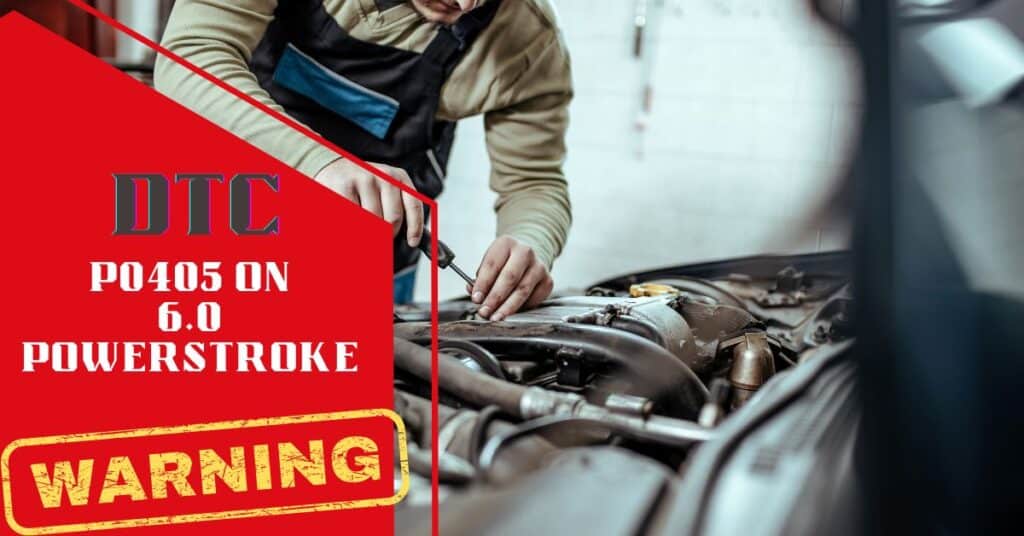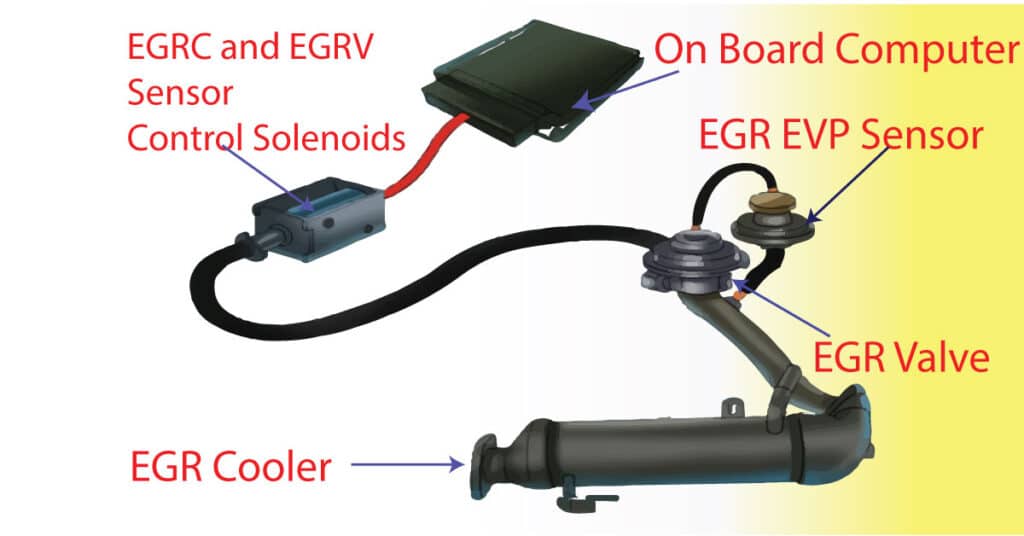The Powertrain Control Module acts as the main computer of your Ford 6.0 Powerstroke truck. Abbreviated as the PCM, this component controls the engine and transmission. And if it detects an issue with the engine, it throws a Diesel Diagnostic Trouble Code or DTC.
There are several DTC codes to keep note of; one of the most common is the P0405. This code is similar to the P0403 in that it relates to the Exhaust Gas Recirculation system or EGR.
However, these two codes should not be confused, and it is essential to know what problem each code relates to. In this article, we will be taking a closer look at the P0405 code, what it means, how to fix issues arising from it, and its symptoms.

What Does The P0405 code mean?
The 6.0 Powerstroke engine, like many others, has an EGR system. The primary function of this system is to minimize the production of nitrogen oxide gas to an acceptable emissions level. It does this by routing the exhaust gas back into the combustion chamber.
The EGR system has a valve that allows for the routing of the exhaust gas back into the combustion chamber. There is also a position sensor that controls and adjusts the operation of the valve. This sensor sends signals to the PCM.
When the PCM detects a lower-than-usual voltage from the sensor, it triggers the P0405 DTC. Therefore, this code relates to the electrical signals sent from the EGR sensor. From this, it may be reasonable to suspect a faulty EGR position sensor.
However, more often than not, the lower-than-average voltage causing the code is usually due to a faulty EGR valve.
Signs of the P0405 DTC code
This DTC will be accompanied by several visible signs. These signs are;
- Check Engine Light is On; The first sign will be the check engine light is on. When the PCM throws this DTC, it will also trigger the check engine light on. It is worth noting that the PCM will do the same for other DTC, including the P0403. Therefore, this alone is not sufficient to indicate a P0405 DTC-related problem.
- Poor Acceleration: Due to the low voltage reading from the EGR position sensor, the EGR valve will open up more frequently. This leads to an insufficient air-to-fuel mixture, which causes the engine to stall or hesitate when accelerating. Thus another sign will be a lack of acceleration and engine stalling.
- Low fuel economy: Another result of the imbalance air to fuel mixture caused by the frequent opening of the EGR valve is a lower-than-usual fuel economy. Your car will have to consume more fuel to compensate.
- A problem with the EGR system will also cause your car to have a rough or erratic idle.
- Finally, your car will obviously produce more nitrogen oxide through the exhaust. You are unlikely to pass an emissions test when this code is triggered.
Common Causes of the P0405 DTC
- The EGR valve position sensor is one of the first components you need to examine when you get this code. A defective sensor will cause the PCM to trigger this error.
- If the sensor has no problem, the culprit is most likely a defective EGR valve. If you hear knocking noises from the engine, then chances are it is a faulty valve. A damaged EGR valve will cause the PCM to trigger this DTC.
- The DTC cans also be due to a short circuit leading to the EGR sensor.
- Issues with the wiring to the EGR sensor will also cause this code. This can be corroded or grounded wires from the EGR sensor. It can also be due to shortened wiring to the sensor.
- The issue may also be caused by a stuck EGR valve. This typically happens due to the buildup of soot and carbon deposits in the valve.
- In rare cases, the DTC may result from a malfunctioning PCM. However, if the PCM is the problem, it will also trigger other DTC. So if you are only getting the P0405 code, a faulty PCM is unlikely to be the cause.
How Serious is The P0405 code
While you may not consider this the most serious DTC, it does not mean you should leave it unaddressed. The PCM will disable the EGR system when this code is triggered. A faulty EGR system will lead to other serious issues, such as problems with the intake system and other engine components. Thus it is wise to have the problem checked and fixed as soon as possible.
Diagnosing The EGR P0405 Error Code

The first thing to do is check for any other DTC codes. You should check for the presence of other codes before proceeding to the next step.
Inspect the Valve
If there are no other codes, the next thing to do is inspect the EGR valve. Inspect the wiring and ensure the wiring connector is secure.
Check the Circuit Voltage
Use a multimeter to check the EGR valve’s reference wire. Make sure the ignition is on. The multimeter reading should be 5 volts. If you do not get 5 volts, check to see if the circuit is shortened or open.
Check Reference Voltage
Next, check the reference wire. Inspect the signal wire of the circuit. The position sensor should give a 100% reading. If this is not what you get, check for an open or short in the valve’s signal circuit.
How to Fix a P0405 Error Code
What should you do when you get the P0405 error code? There are several things you can do to resolve the issue. So if you are comfortable handling your 6.0 L Powerstroke engine at home, here are a few things you can do.
Clean The EGR Valve
As already mentioned, the P0405 code may be due to a clogged-up EGR valve. If you use your car for short-distance urban driving, you are more likely to have a clogged-up valve. Faster and longer-distance driving allows the engine to become hot enough to eliminate carbon and soot buildup.
Here is how to clean the EGR valve.
Step One: Find the Valve
On a 6.0 Powerstroke, the EGR valve is located at the front of the intake manifold. It will typically have two 8 mm bolts securing it.
Step Two: Remove the Valve
Take an8 mm socket to remove the two bolts on either side of the valve. Next, use a channel lock wrench and slide the valve to the side. Then use a crowfoot prybar to remove the EGR valve.
Step Three: Clean The Housing
Once the valve is removed, you will notice the valve housing is very dirty. Clean it first by wiping out the black soot and carbon buildup. Ensure the rag or cloth you use is not stuck or pieces of it get left in the housing.
Step Four: Clean the Valve
Using a screwdriver, first scrape out all the soot buildup on the base of the valve. Then hold up the valve and use a carburetor cleaner to clean the valve. Spray the cleaner on the valve. It is also a good idea to replace the valve O-ring and gasket with new ones.
Replace The EGR Valve
If cleaning the EGR valve does not resolve the issue, then you will have to replace the EGR valve. A faulty EGR valve is actually the most common cause of this error code. Once you remove the EGR by following the steps followed when cleaning, replace it with a new one.
Can I Drive With The P0405 Code?
Yes, you can still drive with this code on. However, it is not advisable as it will put pressure on the engine and lead to more damage. The best cause of action is to have the issue checked and fixed as soon as possible.
Last Updated on September 29, 2025 by Rifen
